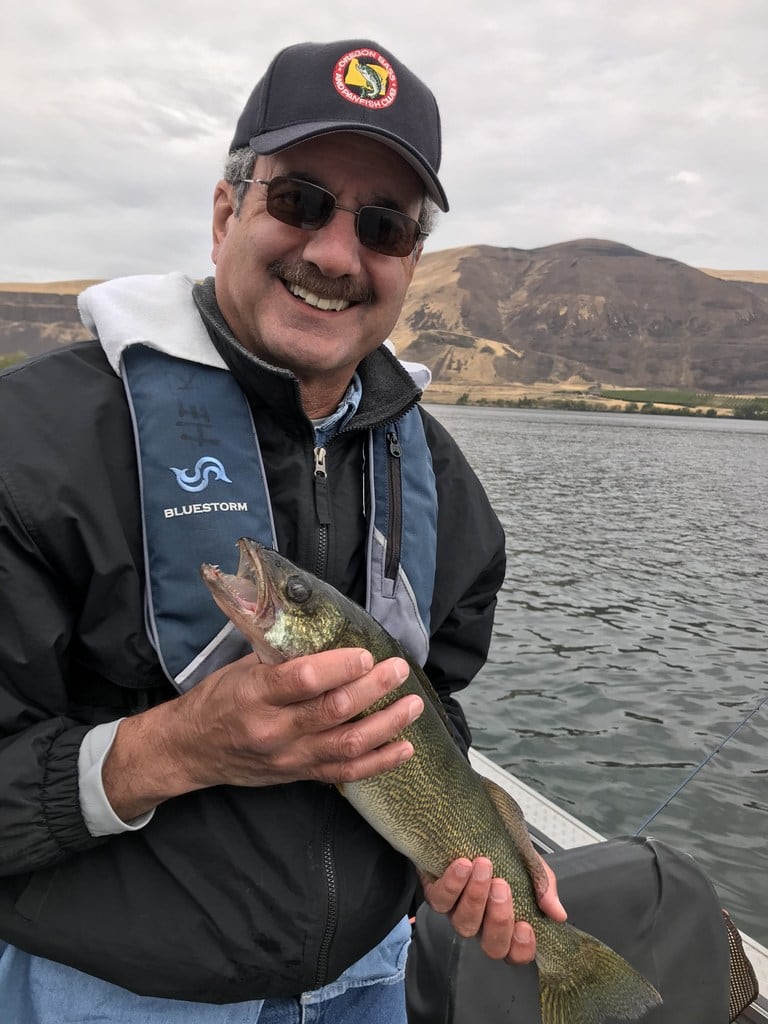Nearly a decade after Oregon and Washington ended bag and size limits on walleye and bass in the jointly shared (and Washington waters) of the Columbia and Snake rivers to help save salmon and steelhead…
Times are a-changing.
The salmon family is still just hanging in there, but although the Columbia is no longer viewed as a likely origin for the next world record walleye, currently held by a 25-pounder landed in Old Hickory Lake near Nashville, Tenn., walleye and bass — both are non-natives, considered invasive — have significantly expanded their ranges.
Both piscatorial predators seem to be on the rise, especially walleye, which are also expanding their influence in the Snake River all the way up to the Salmon River (probably lower; they don’t much care for whitewater).
Walleye were introduced in the mid-20th century into Lake Roosevelt (Grand Coulee Dam) for food and sportfishing.
From there, they made their way downriver and by 1980 were found in sport catches all the way to Rufus. Today’s catches range from Vancouver and Portland, mostly Multnomah Channel, to the Willamette system’s Dexter Dam and Lookout Reservoir.
(
New invasive warning:
Efforts are underway in Lake Roosevelt to eliminate northern pike in the hopes of keeping them from doing the same.)
(
Nostalgic-note:
In 1988, I took the winner of that year’s Oregonian Fish Story Contest on a walleye trip out of Boardman. We caught limits weighing seven to 13 pounds by trolling worm harnesses, lightly ticked along the bottom next to submerged mounds. The late guide Mike Jones urged the winner’s wife to mount her 13-pounder because “That’s a wall hanger,” he said. “I don’t fillet anything over 12 pounds.” Later, he added: “You can’t fish the walleye out…They’re here to stay.”)
The spreading influence of walleye underlies the positive results of the pikeminnow bounty program, which began in 1991 after several years of intense research into the feeding habits of pikeminnows, walleye and smallmouth bass.
Results from the John Day pool became a much-quoted standard for juvenile losses: Pikeminnow take – 78 percent; walleye – 13 percent, and bass 9 percent.
But no longer.
Biologists have shifted the paradigms from levels of blame to a more positive emphasis on loss reduction.
A 10-20% annual reduction in pikeminnow numbers now corresponds to 20-40% annual savings in the loss of juvenile salmonids to all three species.
“The system has been changing,” said Grant Waltz, pikeminnow program leader for the Oregon Department of Fish and Wildlife. “It’s (Columbia River) dynamic … and different from pool to pool.”
The most significant changes, some inherent at the time, have become clearer.
Climate differences, warming, water temperatures, snowpack, dam operations (spill, e.g.), diversions for agriculture, avian predation by cormorants, terns and gulls, even relationships between predatory fish themselves are all woven into a cobweb of factors influencing salmon and steelhead losses.
“There are changes in predator relationships to each other,” Waltz said. “When one is removed, another may fill that space. At the time (mid-80s) we didn’t know what to expect.” (In biological parlance, it’s called “compensation” and often is far beyond compensatory.)
Most of his team’s work occurs from below Bonneville Dam to about John Day Dam on the Columbia River and on the Snake from its confluence on the Columbia to Lewiston/Clarkston.
They use electro-shocking to bounce predatory fish to the surface to check the menu. Results are then compared with those from past years.
Crayfish, shad fry, other crustaceans and baby lamprey join salmonids in most bellies. Anecdotally, walleye take a surprising number of salmon in Bonneville’s tailraces.
And reductions in juvenile salmon found in pikeminnow stomachs support the bounty program’s success.
But while those firm results account for losses at the dams, Waltz cautions against overlaying them throughout all pools.
Walleye have spread their fins high into the Columbia and Snake systems, but in the John Day pool, 7 to 13 pounders like those we caught in 1988 are rare fare these days around those sunken mounds.
“You can’t expect a one-size, set-it-and-forget-it solution,” Waltz said. “It neglects the (total) system we’re working in.”
Meanwhile, for sport anglers, there are two significant takeaways:
First and foremost, for those who question the value of the bounty on pikeminnows and point to the apparently unchanged dilemma of salmon returns, consider the fact that the nearly exponential explosion of avian predation, especially in the salmon nursery at the Columbia River’s mouth, is only a few decades old.
Without the removal of pikeminnows, there’s no question the salmon’s struggles would be much, much more challenging.
The bounty has likely kept salmon and steelhead out of an even deeper hole – and we anglers (and tribes, commercial fishers, etc.) on the water.
Finally, consider the expansion of walleye and smallmouth bass as a bonus.
And, perhaps, a window to the future of angling.
After all, unlike the salmon’s fragile crystal ball, they’ll never become museum pieces on the Columbia.





More Stories
Bill Monroe: Where’s walleye? Piscatorial predators expanding range in Columbia
Bill Monroe: Where’s walleye? Piscatorial predators expanding range in Columbia
Bill Monroe: Where’s walleye? Piscatorial predators expanding range in Columbia